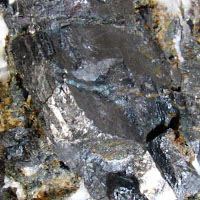
Photo of wolfram ore of which tungsten is extracted.
Tungsten Described
Tungsten is a metallic chemical element classified among the transition metals of the periodic table of elements and it's atomic number is 74. It is well known for its strength and durability, which make it extremely useful in a wide range of industrial applications. Some consumers also own products which contain tungsten or were produced with the metal. When it is isolated, tungsten in a very hard, brittle, gray to white metal that is extremely corrosion resistant.
Where is Tungsten Found ?
The world's major sources of this element are Russia, Austria, China, and Portugal, where it is extracted from minerals such as scheelite and wolframite. This element is not found in a pure form in nature. It has the highest melting point and tensile strength of any metal, and it also has the lowest vapor pressure point. The metal is identified with the symbol W on the periodic table of elements, a reference to its alternate name, wolfram.
Discovery of Tungsten
People have known about the existence of tungsten since at least the early 1700s, when observers noted that the metal interacted with tin. In 1784, the de Elhuyar brothers managed to isolate it in Spain, using tungstic acid extracted from wolframite. Tungsten has classically been a very valuable metal, since its durability and strength make it extremely useful for military and industrial uses..
Tungsten Properties
|
Atomic Number
|
74
|
|---|---|
|
Atomic Mass
|
183.84
|
|
Oxidation State
|
2+,3+.4+,5+,6+
|
|
Melting Point
|
3420°C
|
|
Boiling Point
|
5927°C
|
|
Density at 20°C
|
19.3 g/cc
|
|
Crystal Structure
|
BCC
|


